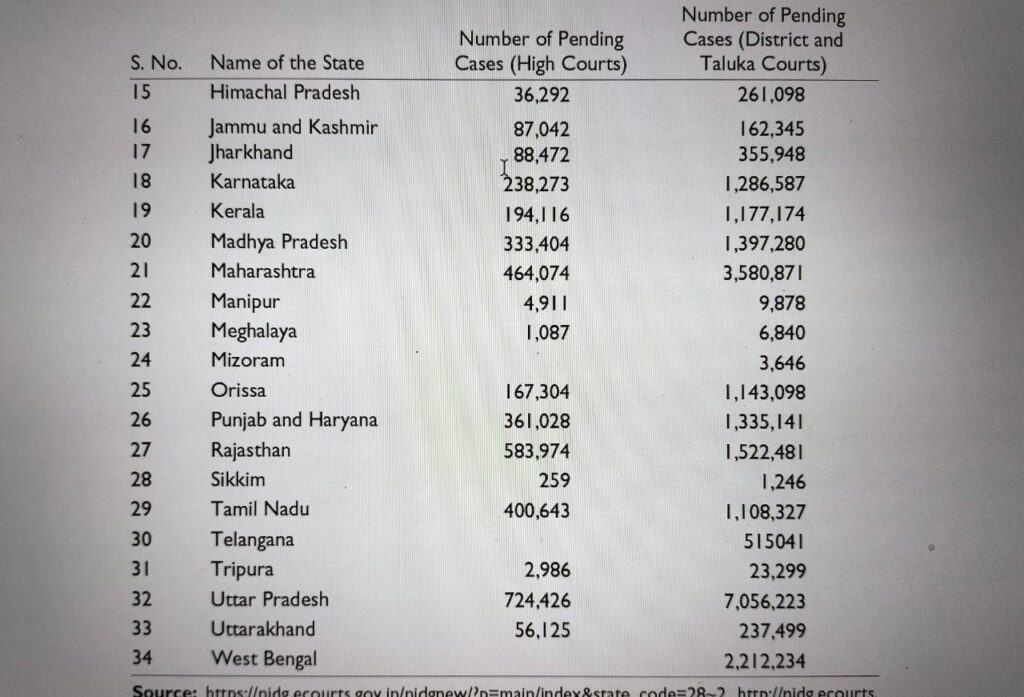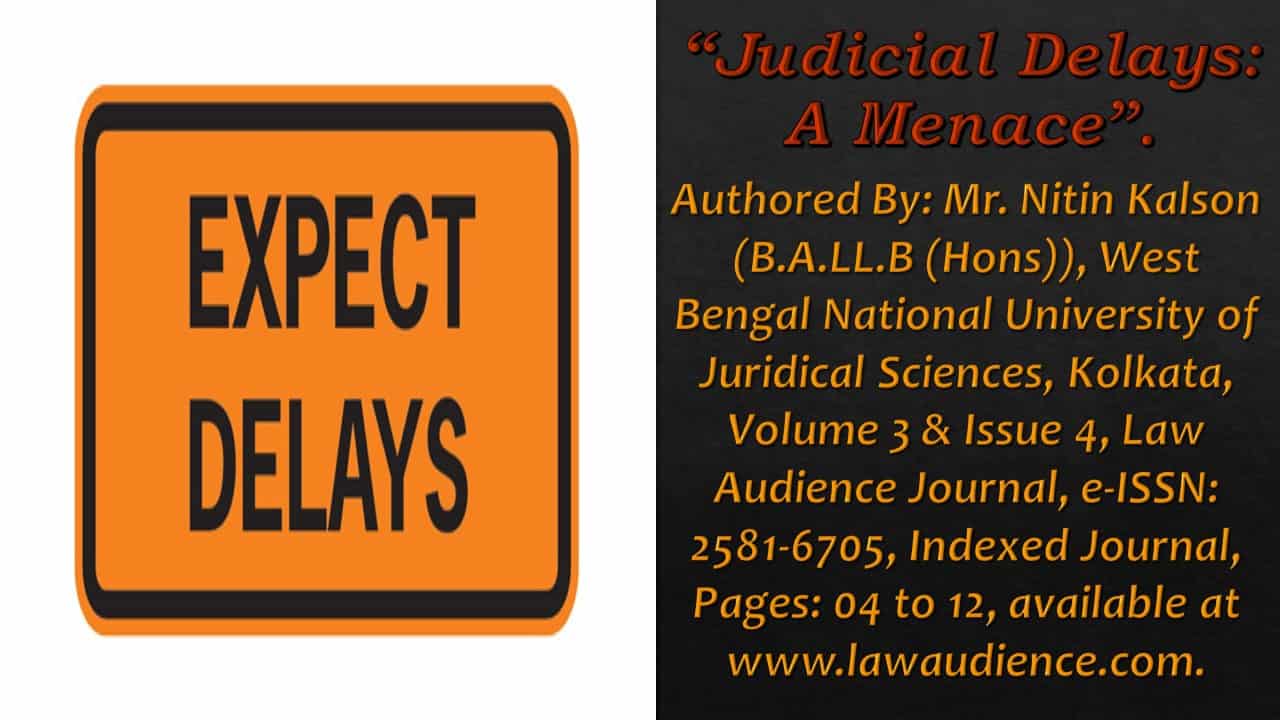Click here to download the full paper (PDF)
Authored By: Mr. Nitin Kalson (B.A.LL.B (Hons)), West Bengal National University of Juridical Sciences, Kolkata,
Click here for Copyright Policy.
ABSTRACT:
“Judiciary is an integrated federal hierarchy of courts settled under the states and districts which interprets and applies the law in a particular state.” The Indian Judiciary finds its origin from the constitution of Republic of India. However, from last two-three decades there have been various questions raised on the working and efficacy of this outlet. These kinds of questions have a direct effect on the faith of public of the state and at a peculiar stage, the faith starts eluding. Some argue that this outlet of government was just laid down by the constitution and wasn’t properly implemented. This failure in implementing the stated type of unbiased judicial procedures can be seen clearly nowadays through the delays in providing justice to common people. It takes years to provide a rational judgement and nonetheless, this statement can also be found biased from one or another viewpoint. Therefore, this paper tries to bring light on the delays and the aspects related to them especially focusing on the state of judges to analyze the harsh reality of present state of Indian judiciary.
I. INDIAN JUDICIARY-CHRONICLE SHIMMER:
The beginning of the Indian Judicial System can be traced back to Anglo-India era when the judicial system was at its primitive stage[1]. The second phase of history of the Indian Judicial System commences from the establishment of the Supreme Court of Judicature at Fort William (Calcutta) under the Regulating Act, 1773 enacted by the British Parliament[2]. The Indian judiciary follows federal system of courts. The Indian federal court’s working and structure is far better than any other system of courts across the world as provided in our constitution. Since now, in India, the judiciary had been doing really great job in terms of functioning, managing and stabilizing the whole country as compared to two other outlets of government i.e., executive and legislative as well as the other forms of parliamentary branches.
As far as I am concerned with this topic, there should be three objects in judiciary being the pillars of it, to become efficient, which are;
- The faith of general public in judges and judicial processes,
- Neutral and unbiased thinking of judges towards people.
- Limited control of executive on the judicial branch and its decisions.
Any judicial system which holds these three characteristics, then that will be one of the most efficient judicial systems. In case of Indian judiciary, it has failed in showing every object up to some extent and that is the drawback of Indian Judicial system. The faith objective is clearly lacking in Indian judicial processes, for instance, Justice Madan Lokur in his article mentioned, “Through its Ayodhya verdict, the apex court emboldened the Hindutva forces. It is not clear as to how under a secular Constitution, a court could issue direction for building a temple, an issue that is now before the Supreme Court, the Central government placed Opposition leaders under house arrest, When a request was made for an urgent hearing on the CAA, the Supreme Court said it would be heard only after the Sabarimala review petitions.”[3] These three instances provide sufficient evidence to establish that Indian judiciary is not in a position to restore the lost faith of public.
II. JUDICIAL DELAYS AND STATE OF JUDGES:
“Justice delayed is justice denied.”,
“According to a source more than 22 million cases are currently pending in district courts, 6 million of which have been lingering for longer than 5 years. The number of cases waiting to be heard in high courts is 4.5 million, and that in the Supreme Court is more than 60 million as per the recently available official data. These figures have been decennially increasing rather than going down (Doshi, 2016).”[4] There are a lot of sources which sings the same thing. There are two tables provided with some statistics of supreme and high courts,[5]
IMAGES 1 AND 2[6] presents the no. of pending cases as Dec. 2018.


Table 2[7]. Sanctioned Number of Judges, Working Strength and Vacancies in Supreme Court and High Courts.
S.No. Name of the Court Approved Working Vacancies
Strength Strengths
Supreme Court 31 27 4
High Court
1 Allahabad 160 110 50
2 Telangana and Andhra 61 28 33
Pradesh
3 Bombay 94 72 22
4 Calcutta 72 37 35
5 Chhattisgarh 22 15 7
6 Delhi 60 39 21
7 Guwahati 24 19 5
8 Gujarat 52 29 23
9 Himachal Pradesh 13 8 5
10 Jammu and Kashmir 17 9 8
11 Jharkhand 25 19 6
12 Karnataka 62 33 29
13 Kerala 47 38 9
14 Madhya Pradesh 53 35 18
15 Madras 75 61 14
16 Manipur 5 3 2
17 Meghalaya 4 3 1
18 Orissa 27 14 13
19 Patna 53 28 25
20 Punjab and Haryana 85 55 30
21 Rajasthan 50 25 25
22 Sikkim 3 3 0
23 Tripura 4 3 1
24 Uttarakhand 11 9 2
Total 1111 722 388
These stats clearly represents that there is no doubt regarding the delays in the cases. Another factor that these sources reflect is the condition of judges and the burden imposed on them of clearing these backlogs. “Acc. to a survey, a high court judge earns Rs. 208 per case hearing of a day but if we compare it to that of lawyers, it shows the ground reality of judge’s personal life.”[8] This creates a negative fact in the mind of judges that they are underpaid and after all this burden and improper/ unequal working conditions, we expect them to be neutral under all situations and provide a rational judgement. For instance, a bribery case is presented further to show the delays in judicial processes. Generally, a bribery case goes up to 3 or 4 years but our one is in trial from last 7 years with a custodial jail of 4 months and the amount associated here is rs.2500 and the surprising fact which comes here is that the case in itself a false one. The case is in itself enough to show the judicial delays in India.
III. REASONS:
The reasons of judicial delays in India are plentiful which includes lesser number of judges, poor infrastructure of courtrooms, complex language of civil and criminal procedure code, no reliance on tribunals and Lok Adalat’s, slow modernization of courtrooms and having no belief in other mechanisms. This massif of pending cases is paid more attention when a heavily dense state is concerned. Delays are not only limited to these reasons. Another reason is the persons involved in the judicial processes e.g., lawyers, writers. “A new systematic study by the Vidhi Centre for Legal Policy, New Delhi, of 8,086 rulings of the Delhi High Court between 2011 and 2015, reveals, rather confirms, the endemic delays still plaguing the Court. Delay in this study is defined as such if a case has been in court for more than 2 years, it tries to find out the reasons for the delay. Its finding is that in 91 per cent of delayed cases (exclusive of 36% cases timely disposed of), it was the lawyers who asked for postponement. The study concluded that 82 per cent of all delays could be attributed to the lawyers and not to the judges per se”.[9] The lawyers try to extend the hearings as much as they can even if the case has nothing. They can come ahead with the idea of strikes. “The Supreme Court bench stated that lawyer strikes are one of the major reasons for pendency of cases. As per the High Court of Uttarakhand, advocates were on strike for 455 days between 2012 to 2016. That means that on average, lawyers went on strike for 91 days per year.”[10] Significantly, a part of courts is itself responsible for delays and the whole blame comes upon the judges and judicial processes. Another reason for the delays is the government itself. Yes, the government can be held responsible for delays. In Nov, 2018 the SC bench was hearing a PIL on pathetic condition of under-trial prisoners and the supreme court criticized the government for delaying the procedures. This is not only a single time; it happens a lot.
“In order to form an effective judiciary, it is necessary that the judiciary form an integral part of the society. Judiciary’s interaction with society is a must and it should be both regular and relevant.”[11] “Several countries involve their citizens in judicial decision making, however, in India, there is no such setup. The citizens need to actively take part in judicial activities to build an effective judicial system.”[12] This para highlights the judicial non interaction with society which is a must be thing for a proper functioning of courts. This also can be related to transparency lack in the procedures of courts. Recently, CJI Ramana has taken a great initiative to launch all court proceedings live on a app. The point to note here is that this idea is itself at a delay of 8 years. This is because in 2012 Justice Deepak Mishra proposed this idea. But now it seems that it has become a habit to procrastinate. CJI is trying to get over with these riddles one by one. He is paying more attention towards the rural people to gain their faith back and make them aware of the judicial processes. Now, as of the new CJI N V RAMANA’s perspective, we can expect that the lost faith of the people in judiciary will be gained back.
IV. SUGGESTIONS:
Modern problems require modern solutions. So, the first suggestion that can be applied to make judiciary more effective is to digitalize and simplify the procedure and proceedings of the courts. This alone can have a huge impact and honorable Justice Ramana had noticed this. This can lead to awareness of rural and backward peoples and will have them to gain some legal knowledge and act wisely in society that will lead to upliftment of society. This will help in the Digital India initiative and will incline India towards the superpower concept. Also, it will help the judges and lawyers to have a fast access to decisions and court orders. In case, if a judge is referring to a particular case, it will be easy for him to just type the case name and get all the information related to it and so with the lawyers.
The second suggestion is to reduce burden on the judges. Psychology says that under pressure, nobody can make a rational decision. So, isn’t that rule applies to judges? The way to reduce the pressure from the judges is to increase the number of judges in respective courts. This can help in clearing the huge backlog more easily and quite promptly. As recently, there are cases of assault with judges, more security and a governing body should be established. This will help in two ways; first way is that the judges will feel more safer and will work without any fear and will provide unbiased judgements. The other way is that corruption amongst judicial processes can be brought down to an extent.
Hence, by making some modifications, various results can be acquired and the faith of the public can be established in the judiciary again.
Bibliography:
Journals:
- Singh, T. & Thakur, A.S., 2019. Administration of Justice: JUDICIAL delays in India. Indian Journal of Public Administration, 65(4), pp.885–896.
- Moog, Robert, 1 Nov. 1992. Delays in the Indian Courts: Why the Judges Don’t Take Control, https://doi.org/https://www.jstor.org/stable/27976795, 16, pp. 19–36.
Articles:
- NIOS 2020, ‘Introduction to English Law’, NIOS, 10-5-2020, viewed 25 Sept 2021, https://nios.ac.in/media/documents/SrSec338New/338_Introduction_To_Law_Eng/338_I pdf.
- N G R Prasad & K K Ram Siddharta, 2020, ‘Tweeting in court: Why reporters must be given guidelines’, The Hindu, 9 March, viewed 19 November 2021, <https://www.thehindu.com/opinion/letters/faith-in-judiciary/article31017217.ece >.
- Patidar, S. (2018), ‘Biggest challenge faced by Indian judiciary’ – ipleaders, in, Accessed: September 25, 2021, https://blog.ipleaders.in/biggest-challenge-faced-indianjudiciary/.
- Mahapatra, Dhananjay (2021), ‘A retired SC judge can get paid more in 2 hours than a serving one in a month’, The Times Of India, Accessed: September 25, 2021
http://timesofindia.indiatimes.com/articleshow/84307245.cms?utm_source=contentofinterest&utm_medium=text&utm_campaign=cppst.
Cite this article as:
Mr. Nitin Kalson, “Judicial Delays: A Menace”, Vol.3 & Issue 4, Law Audience Journal (e-ISSN: 2581-6705), Pages 04 to 12 (25th February 2022), available at https://www.lawaudience.com/judicial-delays-a-menace/.
Footnotes & References:
[1] NIOS 2020, ‘Introduction to English Law’, NIOS, 10-5-2020, viewed 25 Sept 2021,
[2] Id.
[3] N G R Prasad & K K Ram Siddharta, 2020, ‘Tweeting in court: Why reporters must be given guidelines’, The Hindu, 9 March, viewed 19 November 2021, < https://www.thehindu.com/opinion/letters/faith-injudiciary/article31017217.ece >.
[4] Singh, T. & Thakur, A.S., 2019. Administration of Justice: JUDICIAL delays in India. Indian Journal of Public Administration, 65(4), pp.885–896.
[5] Id.
[6] Id.
[7] Id.
[8] Mahapatra, Dhananjay (2021), ‘A retired SC judge can get paid more in 2 hours than a serving one in a month’, The Times Of India, Accessed: September 25, 2021,
http://timesofindia.indiatimes.com/articleshow/84307245.cms?utm_source=contentofinterest&utm_medium=text&utm_campaign=cppst.
[9] Singh, T. & Thakur, A.S., 2019. Administration of Justice: JUDICIAL delays in India. Indian Journal of Public Administration, 65(4), pp.885–896.
[10] Patidar, S. (2018), ‘Biggest challenge faced by Indian judiciary’ – ipleaders, Ipleaders.in, Accessed: September 25, 2021, https://blog.ipleaders.in/biggest-challenge-faced-indian-judiciary/.
[11] Id.
[12] Id.





